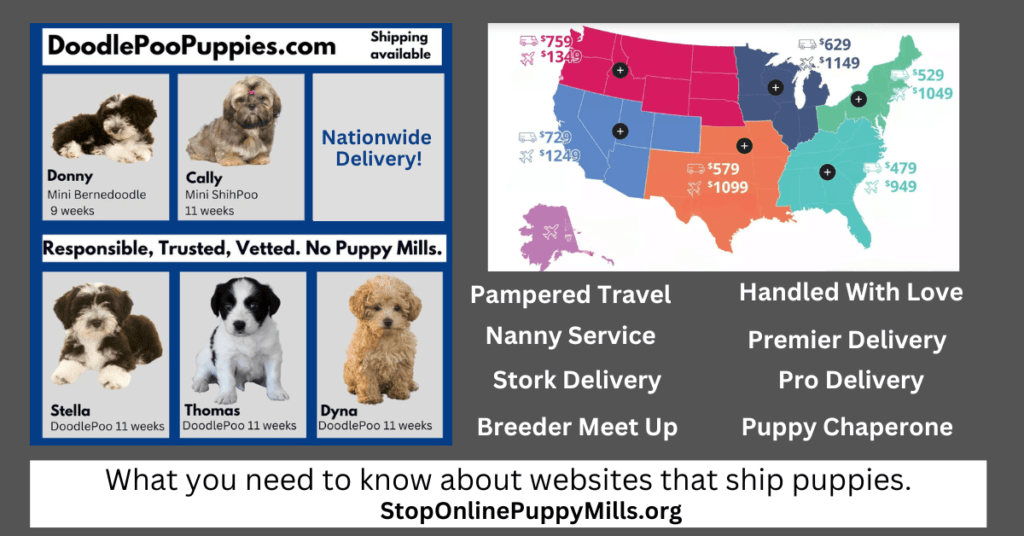Why You Should Think Twice Before Buying a Puppy from a Website That Offers Delivery
In today’s digital age, almost everything is just a click away—including, unfortunately, puppies. Many puppy-selling websites and breeder platforms now advertise delivery via plane, commercial transport, “puppy nannies,” or even parking lot meet-ups. While this may sound convenient, it raises serious concerns about animal welfare, online puppy mills, transparency, and the origin of the puppy.
If a website promotes fast, no-visit-needed delivery, it’s time to pause and ask: Why don’t they want you to see where the puppy came from?
Planes, Trucks, and Parking Lots: Not Safe, Not Transparent, Not for Puppies
Transporting a puppy by plane, truck, or courier can be extremely stressful to a young puppy. Many puppies are shipped shortly after being weaned, placed in crates for hours (or even days), exposed to loud environments, disease, fluctuating temperatures, unfamiliar handlers and even stored in warehouses. They often arrive to their new families sick, dehydrated, or traumatized.
Websites use all sorts of marketing terms such as “puppy nanny” services that sound gentle and caring. The truth is: these delivery methods bypass critical transparency checkpoints. When you don’t see the facility, meet the mother dog, so you can see her mental and physical conditions in person, you have no way of verifying where your puppy came from—or the conditions it was raised in.
Where Do These Puppies Really Come From?
The uncomfortable reality is that many puppies sold online with nationwide delivery come from high-volume commercial dog breeding operations. These breeders—are usually USDA licensed dog breeders, that likely prioritize quantity over quality, operating with 40 to hundreds of dogs bred repeatedly to meet demand. These facilities are often referred to as puppy mills.
Because these breeders rely on third-party delivery services, they don’t need to interact with buyers directly. This model allows them to:
Avoid showing you the conditions the dogs live in
Distance themselves from questions about the parents’ health or temperament
Operate without transparency
Puppy broker websites look polished and professional, are basically third party sellers connecting buyers with a network of commercial breeders, They ship the puppies like products.
When delivery is the norm and breeder information is withheld until after payment or deposit, that’s a strong indicator of a system designed to move puppies fast.
Responsible Breeders
Responsible breeders typically:
Encourage in-person visits and are proud of how their dogs live
Want to meet and interview potential puppy owners
Raise their puppies in-home
Have a limited number of litters and prioritize the wellbeing of every dog
If a breeder or website doesn’t offer transparency, but offers cross-country delivery, that’s a red flag. Convenience should never come before compassion.
Red Flags to Watch For
Be cautious of websites or sellers that:
Emphasize fast delivery or “shipping available nationwide”
Offer to meet in a parking lot, airport, or public space
Refuse to let you meet the mother dog or see where she lives
- Request payment before you can are allowed to know the breeder’s name and address.
What You Can Do Instead
Adopt from a local shelter or rescue—you’ll save a life and avoid hidden cruelty
Avoid buying a puppy online.
Educate others to look beyond the convenience and recognize red flags
Puppies are Alive
Bringing home a puppy should never feel like you are ordering a product off a quick ship website. When a seller offers to deliver a puppy by truck, plane, or “nanny”—without letting you see where the puppy was born or raised—in person-there’s a high likelihood the puppy came from a high-volume, commercial breeder or a puppy mill.
At Stop Online Puppy Mills, we educate consumers before they buy—so they don’t unknowingly support this industry. Learn more, share, help us protect dogs from a lifetime of cruelty visit StopOnlinePuppyMills.org.








